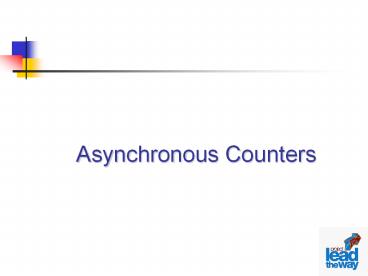Asynchronous Counters - PowerPoint PPT Presentation
Title:
Asynchronous Counters
Description:
Lecture Overview Classifications of Counters Definitions Asynchronous Counter J K Flip Flops D Flip Flops Up Counters Down Counters Truncated ... – PowerPoint PPT presentation
Number of Views:310
Avg rating:3.0/5.0
Title: Asynchronous Counters
1
Asynchronous Counters
2
Lecture Overview
- Classifications of Counters
- Definitions
- Asynchronous Counter
- J K Flip Flops
- D Flip Flops
- Up Counters
- Down Counters
- Truncated Counters
- Design Example
3
Classifications of Counters
- Asynchronous Counters
- Only the first flip-flop is clocked by an
external clock. All subsequent flip-flops are
clocked by the output of the preceding flip-flop. - Asynchronous counters are slower than synchronous
counters because of the delay in the transmission
of the pulses from flip-flop to flip-flop. - Asynchronous counters are also called
ripple-counters because of the way the clock
pulse ripples it way through the flip-flops.
4
Classifications of Counters
- Synchronous Counters
- All flip-flops are clocked simultaneously by an
external clock. - Synchronous counters are faster than asynchronous
counters because of the simultaneous clocking. - Synchronous counters are an example of state
machine design because they have a set of states
and a set of transition rules for moving between
those states after each clocked event.
5
States / Modulus / Flip-Flops
- The number of flip-flops determines the count
limit or number of states. - (STATES 2 of flip flops)
- The number of states used is called the MODULUS.
- For example, a Modulus-12 counter would count
from 0 (0000) to 11 (1011) and requires four
flip-flops (16 states - 12 used).
6
1 Bit Asynch-Counter / Modulus 2
7
2 Bit Asynch-Counter / Modulus 4
8
3 Bit Asynch-Counter / Modulus 8
9
The Ripple Effect
10
Ripple EffectThe Problem
11
D Flip-Flop Nothing Special About J-K
12
Six Examples
- Modulus 4 Up Counter with Negative Edge Triggered
Flip-Flops - Modulus 4 Down Counter with Negative Edge
Triggered Flip-Flops - Modulus 4 Up Counter with Positive Edge Triggered
Flip-Flops - Modulus 4 Down Counter with Positive Edge
Triggered Flip-Flops - Truncated Counter
- Counter Design
13
Up Counter w/ Negative Edge Flip-Flops
14
Down Counter w/ Negative Edge Flip-Flops
15
Up Counter w/ Positive Edge Flip-Flops
16
Down Counter w/ Positive Edge Flip-Flops
17
Truncating the Count Modulus 6
18
Modulus-6 Counter
19
Asynchronous Counter Design Steps
- Select Type
- Up or Down
- Modules
- Select Flip-Flop Type
- J-K or D
- Positive Edge Trigger (PET) or Negative Edge
Trigger (NET) - Determine Number of Flip-Flops
- (2 Flip-Flop ? Modules)
20
Asynchronous Counter Design Steps
- Design Basic Counters
- Same polarity for down counters
- Opposite polarity for up counters
- Design Limits Logic
- Input to logic is count that is one past the end
of sequence.
21
Design Example
- Select Type
- Up or Down
- Modules
- Select Flip-Flop Type
- J-K or D
- Positive Edge Trigger (PET) or Negative Edge
Trigger (NET) - Determine Number of Flip-Flops
- (2 Flip-Flop ? Modules)
MOD 14 (0..13)
24 Flip-Flop ? 16
22
Design Example
- Design Basic Counters
- Same polarity for down counters
- Opposite polarity for up counters
- Design Limits Logic
- Input to logic is count that is one past the end
of sequence.
Limit 131 14 (1110)
23
Design ExampleSolution































